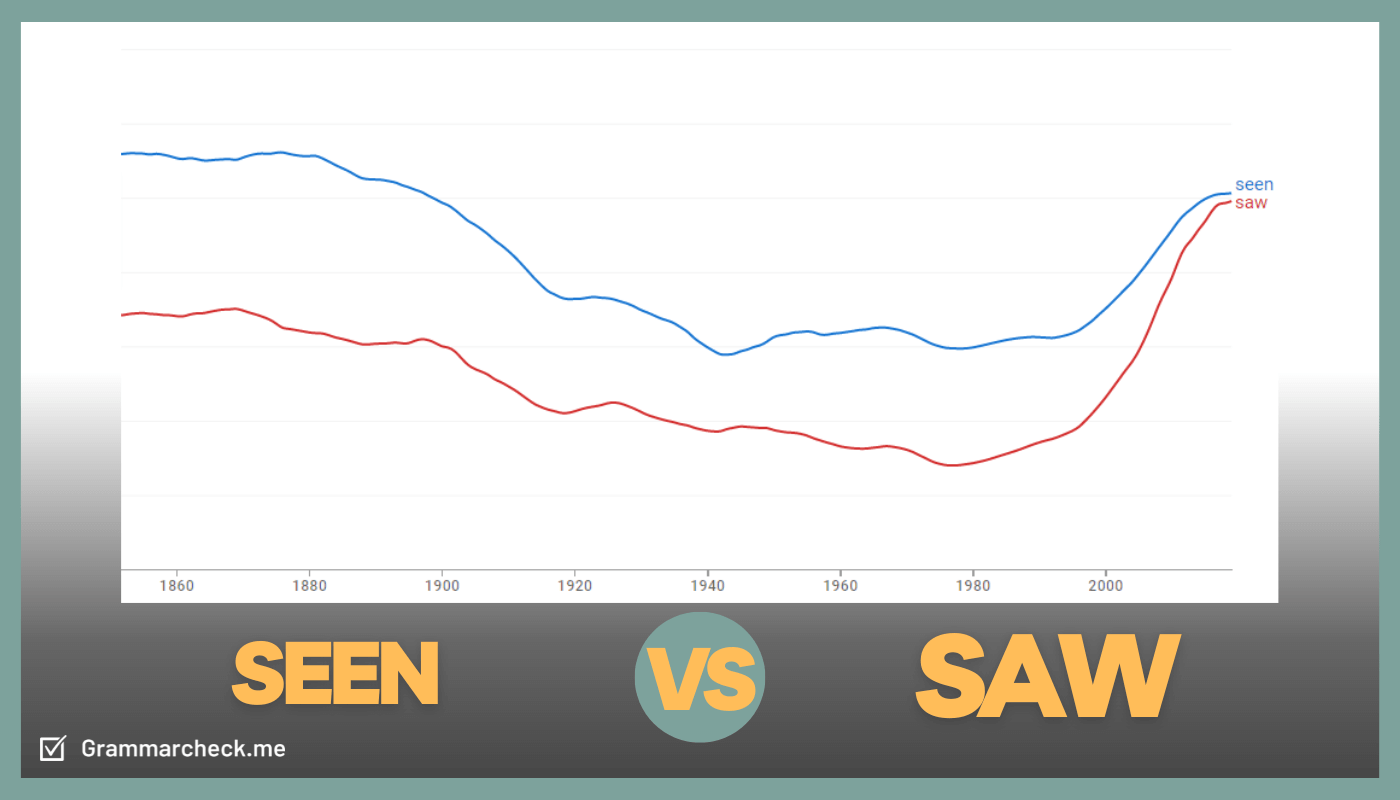The two words seen and saw are amongst the most commonly confused words in the English language today. New writers often get tricked because these words are different forms of the same verb, see. However, these words are NOT the same and cannot be used interchangeably in your writing. In this post, we’ll help you choose effectively between seen or saw with some sentence examples!
What’s The Difference Between Seen or Saw

Just like we saw with the words parent’s vs parents’, small spelling differences can totally change how a word is used. However, many novice writers get tripped up trying to determine the difference between the words saw and seen. Both of these words are different forms of the same stand alone verb, see.
- Saw: The correct past tense form of see is saw. “I saw Tom bump into Steve in the hallway.”
- Seen: The correct past participle form of see is saw. It can also be used to create the perfect verb tenses. “Steve had seen enough and decided to walk out of the movie.”
How To Use “Seen”
The past participle form of the verb “see” is “seen”. This can be used in past, present, and future tense situations to refer to objects which have been noticed through one’s eyes. Just like how writers confuse mourning and morning, they also confuse seen with saw!
- For example, if you needed to say you had seen a beautiful painting recently, you would say something like: “I’ve seen a stunning painting”
Sentence Examples
Here are some examples of how to use seen in your writing.
- I have never seen a movie that I enjoy more than Godfather.
- Steve has seen Episode 6 of the Simpsons 5 times.
- By now, she has seen everything she needed to make a decision.
- I am old enough to have seen Abraham Lincoln take office.
- Tom has seen the 2020 Super Bowl game 3 times.
Just like we observed in our post on have vs has, small spelling differences can make a huge difference. Pay close attention to your word choice!
How To Use “Saw”
Using the word “saw” is a great way to talk about something you witnessed in the past. Saw is the past tense form of the verb “see”, used when describing a situation you observed or experienced. Just like writers confuse the words which and what, they also confuse see, seen, and saw.
- For example, if you were at a music concert last night and heard an up-and-coming artist perform, you could say “I saw this amazing singer last night at the concert.”
Sentence Examples
Here are some examples of how to use saw in your writing.
- I saw your text and I’ll give your a call later.
- Steve saw his favorite movie this past weekend.
- I saw that Mark came in late so I had to report him.
- Jim saw Tom steal his watch from the desk.
- Lebron James slowed down after he saw the defender closing in on him.
Just like we saw in our analysis of grammar vs grammer, small spelling changes can make a huge difference. Pay close attention to your spelling!
Which Is Correct: I Seen or I Saw?
You should have a great understanding of how to use the terms seen vs saw. However, what about the popular phrases “I seen” & “I saw”?
- It is never correct to say “I seen”
- “I saw” is the correct past tense form of the verb phrase “I see”. For example, “I saw the basketball rolling towards me so I bent over to pick it up.”
You may still hear people say “I seen” in casual conversation. However, that is slang and is NOT considered proper grammar! Informal terms like time flies or time flys are used daily in casual conversations!
Which Is More Popular?

As we can see by analyzing Google’s n-gram data, . However, both words are commonly used in written text and conversation today!
Just like we saw when analyzing the words edition and addition, the popularity of certain words can significantly vary over time. As culture changes, so does the vocabulary of authors and academics!
Frequently Asked Questions
You should say “he has been seen”. This is the correct past perfect tense of the verb see. It is also correct to say “I saw him”. However, you cannot say “he has been saw”. The helping verb have requires you to use “seen”.
It is only correct to say “I have never seen”. The helping verb have requires you to use the word “seen” and not “saw”. For example, you might say “I’ve never seen the Godfather Part II before.”
No, it is not grammatically correct to say “I seen” in any context. You can use the present perfect tense, “I have seen a cat before.” You could also use the past perfect tense, “I had seen a cat many times before.” The word “seen” is the past participle of the verb “see”. However, it cannot be used the same as the word “saw”!
Here are some examples of how to use saw in a sentence. “I saw a bat while I was walking home from work.” “Mark saw his favorite movie last night.” “She saw the light turn red and slammed on the brakes.”
The Bottom Line
After reading this post you should be a master of the difference between seen or saw. These are examples of verb tenses and verb endings. The word “saw” is the past tense form of the word “See.” On the other hand, the word “seen” is the past participle form of the word “see”. We use this to create the perfect verb tenses. Hopefully we have clarified this grammar rule so you don’t make this mistake in your writing. If you need some extra help, consider using our free correct grammar check tool to make things simple!
